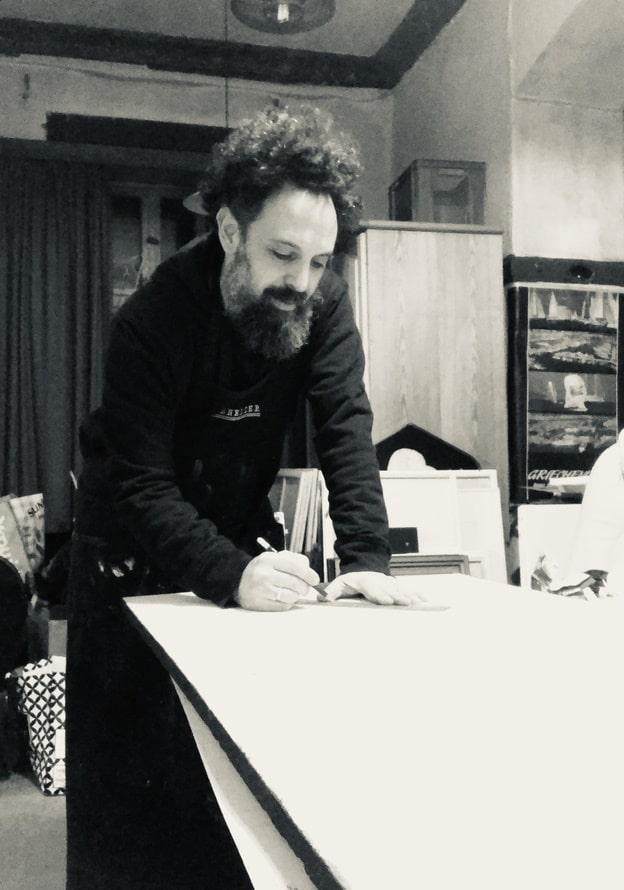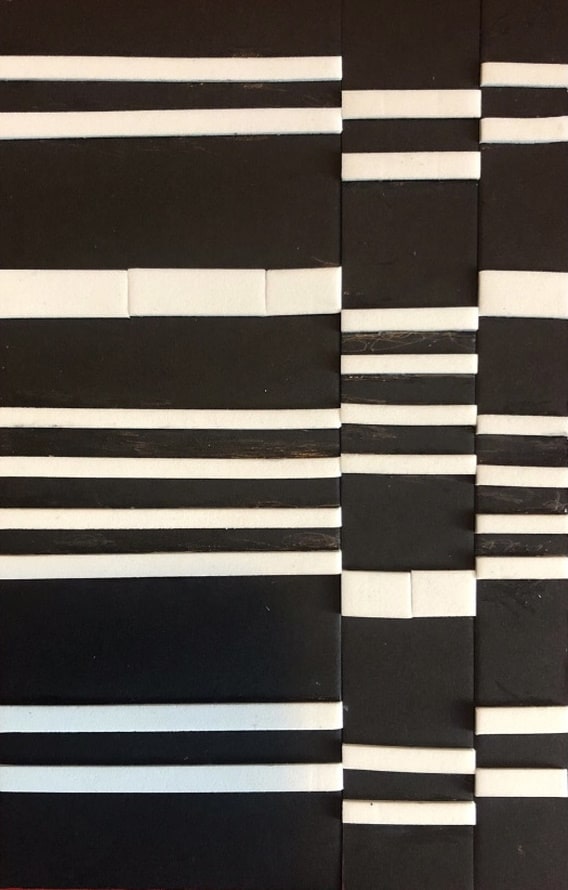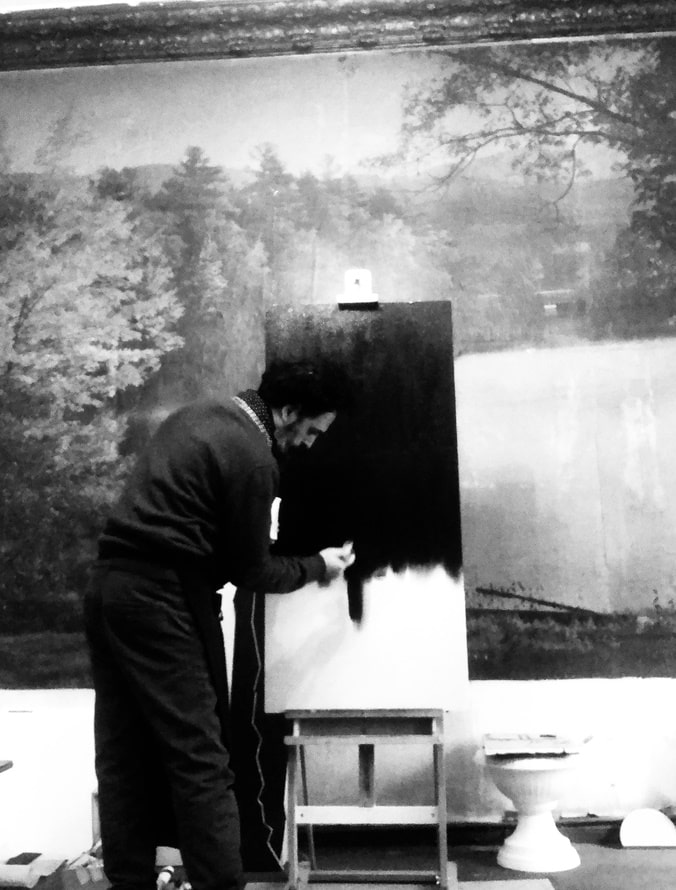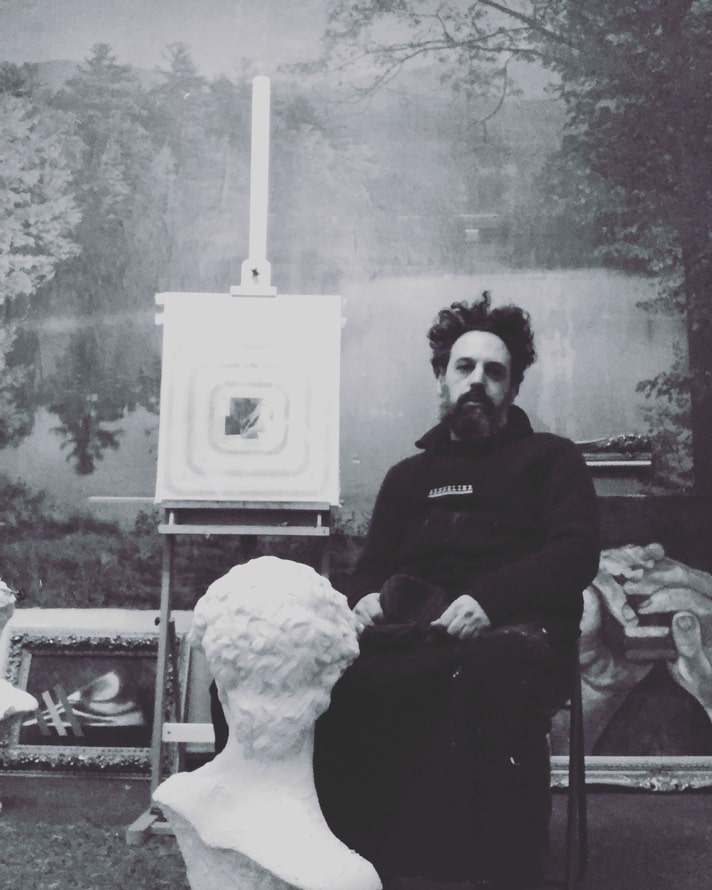PROLOG | PERSÖNLICHES
(Interview in englischer Sprache) Avi, imagine that you would receive us in the studio or at home. Where do we talk together, where do we meet? We would meet at my beautiful Altbau’s studio, located in a former Greek restaurant in Schoeneberg. Maybe we are sitting in your favorite place? My favorite place is the walls of the studio and the secrets they hide inside. You were born in Haifa, Israel, in 1973. Today you live and work in Berlin, Germany. What stations and people have particularly shaped you in your life so far? Most of my life I grew up in Haifa, in the Bat Galim neighborhood at the foot of the mountain and by the sea. At a relatively late age, 27, I took a backpack and traveled in Spain. I’ve been living there for a year. I’ve also lived in Tel Aviv for a short time but I didn’t like the „big city“ that much. I believe that most of my influence comes from my home, my parents who immigrated from Morocco to Israel, and on the other hand the Israeli environment, most of which was based on European culture and the memory of the Holocaust. As a child I often felt foreign, but over the years I found love and inspiration in that feeling.
Which writers do you find exciting at the moment and which books can be found on your bookshelf? Our house is full of books, they almost took over, they are next to the bed, behind the reading lamp and under, in the kitchen cupboards, everywhere. Which books have influenced or shaped you? The first of them was in my twenties, “Life as a parable” by the Israeli writer Pinchas Sade. It was his first book written in the very young Israel, in 1958, that discussed personal thoughts and questions about life as an individual and not as a collective. What are you currently reading and where does the book lie at hand? Lately, it’s been hard for me to devote myself completely to just one book and to disconnect myself. I’m so excited about projects that are coming to fruition in my life right now that I myself write books in my head every day. But the books surrounding our bed a like a guardian golem, watching us while we sleep. What music do you listen to and when? Almost every morning I do 5 minutes of physical excercise to the sounds of Stravinsky’s early piano sonatas, I highly recommend it!

If you were to cook something for us, what would it be? My garlic hummus recipe. Those who come to the opening of my next exhibition will have the opportunity to taste it. What is your favourite food? Any food, except meat, I’m open to everything! What do you think about breakfast? A morning Shabbat at Gina’s, Vita’s and Claudio’s place, an Italian restaurant on Akazienstraße 10 in Schoeneberg, there is nothing better than eating among good friends. What kind of sport or compensation do you do for your artistic work? Meditation, every morning, at least between 10 to 30 minutes, it saved my life! Do you have any special passions (hobbies) that you are passionate about, and if so, which ones? In addition to painting, I compose music and play the double bass. But my favorite hobby is walking with my wife in nature on weekends. What personality trait particularly defines you? –

INTERVIEW | KÜNSTLER + POSITION
We would like to briefly introduce your artistic career. You studied at the Wizo Haifa Academy of Design in Israel, and musical composition in Berlin with the composer and Bach scholar Professor Derek K. Remeš. You were first exposed to the art of painting by your mother, Esther, an Israeli painter. Your father owns a paint shop. Did we miss something? If so, tell us about other stages in your artistic education.
How did you get into art? Why art?
During my military service I worked in a warehouse that supplied materials to the ships of the navy. For hours I would watch the practitioners who came in every morning to work on different machines, every morning the same routine, the same procedure. I think it really stressed me out. I was only 20 years old and that’s not how I saw my life ahead. I signed up for evening classes while in the army, to learn shop window design, and the week I was released from the army at the age of 21, I became the chief designer for a Major pharmaceutical company. I did that for 7 years or so.

What is currently making you happy?
Walking in nature.
What is currently scaring you?
Since I started meditating I am less scared.
Do you believe that art has a social responsibility? And what do you think it can achieve?
Certainly, I don’t see any need for art whose role is not to create change. Any art that is only for sale or for ego or success is meaningless to me. To me art is an expression of a deep intention and the viewer knows how to feel what is a true intention, and what is an insincere intention. There are many beautiful works but only a few that survive time and stay relevant. These are the works that express sincere emotion.

What characterises your art? What is your work about – what are the central themes?
Emotions, structure, construction and deconstruction…
THE DEED | DAS WERK: Avi Albers Ben Chamo
Born in 1973 in Haifa (Israel) and living in Berlin, artist Avi Albers Ben Chamo talks about the central message of his artistic work in his interview.
Please describe the core theme and the central message of your work. Introduce us to the work that, in your view, exemplifies or best embodies the message of your work.
Emotions, structure, construction and deconstruction.

Avi Albers Ben Chamo, Kavanism series: the broken word

Avi Albers Ben Chamo, Kavanism series: the broken word 0.2
Especially in my current works, which I call Kavanism, I feel more and more free to deal with the surface I’m working with, because I know I’m going to destroy it just before the work is finished. But my work is not disconnected from reality, it is a direct reflection of my relationship with society and the political and interpersonal tensions. I am not interested in self-interest only, I do not live in this world in isolation.

Avi Albers Ben Chamo, Kavanism series: the broken square

Avi Albers Ben Chamo, a broken circle movement
THE DEED | DAS WERK is a complementary and separately presented part of THE INTERVIEW IN|DEEDS with Avi Albers Ben Chamo.
How do you protect yourself from too much inspiration in today’s times?
I want to experience reality and reflect it as it is, what’s the point of my art if not to express my opinion on our daily lives?

How much of your work is planned in advance – how much arises intuitively?
I would like to improve, that’s why I am learning to plan ahead, to be more focused on exploring one element at a given moment. But I don’t have a problem if something happens by intuition, on the contrary.
What are your (next) goals?
I am currently all about the preparation of the exhibition of the „Wrong Stripes“ that is part of „Kavanism“. „Kavanism“ is coming from the Hebrew word „Kavana“ intention, kivun, a direction that contain a pure intention.

What is your position on the subject of faith? Do you have principles of faith or is there a motto?
I think I can learn a lot from the Bible about us as a society, but I don’t believe in the religious institutions using the words for their own agenda.
Which project would you still like to realise if a lack of time, courage or financial resources did not play a role?
I would be happy if I could deepen my learning about color and light from flowers, sit on a desert island and just paint them all day.

In your view, what are the attributes of good art?
Sincerity.
Is one born as an artist? Or is studying art compulsory?
Learning is important, but academia has long since lost its ability to define the individual capabilities of an individual.

Who do you show a new work to first?
To my wife.
What does the first hour of your day look like?
I really like the mornings, mornings are like new beginnings. Usually every day after I wake up I compose music until 12.00, practice on the double bass for an hour and then go down to work in the studio until the evening.

In the age of the Internet of Things, are galleries still necessary? If so, why and for what?
I’m not yet represented by a gallery so it’s hard for me to say, as a viewer I’d rather go on a long trip to the museum.
Social media – blessing or curse?
In terms of promoting my art? 90 percent of my paintings are in the homes of people I know or I know through friends who already have a painting. I use social media only as a cheap escape for my emotions, for me it’s just to pass the time, nothing more than that
EPILOG | AKTUELLES.
Die Ausstellung The Wrong Stripes ist vom 27. April bis 15. Mai 2023 (Montag – Freitag 10-18 Uhr) im Fundbüro Design, Mühsamstraße 41/EG, 10249 Berlin-Friedrichshain zu sehen. Die Galerie ist zu erreichen unter info@fundburo.ne oder Mobil: +49 0176 25072449.
ALBERS| Avi Albers Ben Chamo (Instagram @avi.albers)
Die DEEDS-Interviews werden von unserer Redaktion nicht redigiert oder gekürzt und stets im O-Ton wiedergegeben. Daher nehmen wir auch keine Übersetzung des Interviews in Englische bzw. Deutsche vor, es sei denn, diese wird seitens des/der Interviewten eingereicht, oder wir werden mit der Übersetzung betraut. Hier wurde die deutsche Version des Interviews von der Künstlerin eingereicht.






